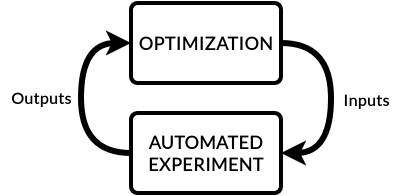Optimizers#
Optimizers are key to building an autonomous laboratory. In EOS, optimizers give intelligence to experiment campaigns by optimizing task parameters to achieve objectives over time. Optimizers in EOS are sequential, meaning they iteratively optimize parameters by drawing insights from previous experiments. One of the most common sequential optimization methods is Bayesian optimization, and is especially useful for optimizing expensive-to-evaluate black box functions.

EOS has a built-in Bayesian optimizer powered by BoFire (based on BoTorch). This optimizer supports both constrained single-objective and multi-objective Bayesian optimization. It offers several different surrogate models, including Gaussian Processes (GPs) and Multi-Layer Perceptrons (MLPs), along with various acquisition functions.
Distributed Execution#
EOS optimizers are created in a dedicated Ray actor process. This actor process can be created in any computer with an active Ray worker. This can enable running the optimizer on a more capable computer than the one running the EOS orchestrator.
Optimizer Implementation#
EOS optimizers are defined in the optimizer.py file adjacent to experiment.yml in an EOS package.
Below is an example:
optimizer.py
from bofire.data_models.acquisition_functions.acquisition_function import qUCB
from bofire.data_models.enum import SamplingMethodEnum
from bofire.data_models.features.continuous import ContinuousOutput, ContinuousInput
from bofire.data_models.objectives.identity import MinimizeObjective
from eos.optimization.sequential_bayesian_optimizer import BayesianSequentialOptimizer
from eos.optimization.abstract_sequential_optimizer import AbstractSequentialOptimizer
def eos_create_campaign_optimizer() -> tuple[dict, type[AbstractSequentialOptimizer]]:
constructor_args = {
"inputs": [
ContinuousInput(key="mix_colors.cyan_volume", bounds=(0, 25)),
ContinuousInput(key="mix_colors.cyan_strength", bounds=(2, 100)),
ContinuousInput(key="mix_colors.magenta_volume", bounds=(0, 25)),
ContinuousInput(key="mix_colors.magenta_strength", bounds=(2, 100)),
ContinuousInput(key="mix_colors.yellow_volume", bounds=(0, 25)),
ContinuousInput(key="mix_colors.yellow_strength", bounds=(2, 100)),
ContinuousInput(key="mix_colors.black_volume", bounds=(0, 25)),
ContinuousInput(key="mix_colors.black_strength", bounds=(2, 100)),
ContinuousInput(key="mix_colors.mixing_time", bounds=(1, 45)),
ContinuousInput(key="mix_colors.mixing_speed", bounds=(100, 200)),
],
"outputs": [
ContinuousOutput(key="score_color.loss", objective=MinimizeObjective(w=1.0)),
],
"constraints": [],
"acquisition_function": qUCB(beta=1),
"num_initial_samples": 25,
"initial_sampling_method": SamplingMethodEnum.SOBOL,
}
return constructor_args, BayesianSequentialOptimizer
Each optimizer.py file must contain the function eos_create_campaign_optimizer.
This function must return:
The constructor arguments to make an optimizer class instance
The class type of the optimizer
In this example, we use EOS’ built-in Bayesian optimizer.
However, it is also possible to define custom optimizers in this file, and simply return the constructor arguments and
the class type from eos_create_campaign_optimizer.
Note
All optimizers must inherit from the class AbstractSequentialOptimizer under the eos.optimization module.
Input and Output Parameter Naming#
The names of input and output parameters must reference task parameters. The EOS reference format must be used:
TASK.PARAMETER_NAME
This is necessary for EOS to be able to associate the optimizer with the experiment tasks and to forward parameter values where needed.
Example Custom Optimizer#
Below is an example of a custom optimizer implementation that randomly samples parameters for the same color mixing problem:
optimizer.py
import random
from dataclasses import dataclass
from enum import Enum
import pandas as pd
from eos.optimization.abstract_sequential_optimizer import AbstractSequentialOptimizer
class ObjectiveType(Enum):
MINIMIZE = 1
MAXIMIZE = 2
@dataclass
class Parameter:
name: str
lower_bound: float
upper_bound: float
@dataclass
class Metric:
name: str
objective: ObjectiveType
class RandomSamplingOptimizer(AbstractSequentialOptimizer):
def __init__(self, parameters: list[Parameter], metrics: list[Metric]):
self.parameters = parameters
self.metrics = metrics
self.results: list[dict] = []
def sample(self, num_experiments: int = 1) -> pd.DataFrame:
samples = []
for _ in range(num_experiments):
sample = {p.name: random.uniform(p.lower_bound, p.upper_bound) for p in self.parameters}
samples.append(sample)
return pd.DataFrame(samples)
def report(self, inputs_df: pd.DataFrame, outputs_df: pd.DataFrame) -> None:
for _, row in pd.concat([inputs_df, outputs_df], axis=1).iterrows():
self.results.append(row.to_dict())
def get_optimal_solutions(self) -> pd.DataFrame:
if not self.results:
return pd.DataFrame(
columns=[p.name for p in self.parameters] + [m.name for m in self.metrics]
)
df = pd.DataFrame(self.results)
optimal_solutions = []
for m in self.metrics:
if m.objective == ObjectiveType.MINIMIZE:
optimal = df.loc[df[m.name].idxmin()]
else:
optimal = df.loc[df[m.name].idxmax()]
optimal_solutions.append(optimal)
return pd.DataFrame(optimal_solutions)
def get_input_names(self) -> list[str]:
return [p.name for p in self.parameters]
def get_output_names(self) -> list[str]:
return [m.name for m in self.metrics]
def get_num_samples_reported(self) -> int:
return len(self.results)
def eos_create_campaign_optimizer() -> tuple[dict, type[AbstractSequentialOptimizer]]:
constructor_args = {
"parameters": [
Parameter(name="mix_colors.cyan_volume", lower_bound=0, upper_bound=25),
Parameter(name="mix_colors.cyan_strength", lower_bound=2, upper_bound=100),
Parameter(name="mix_colors.magenta_volume", lower_bound=0, upper_bound=25),
Parameter(name="mix_colors.magenta_strength", lower_bound=2, upper_bound=100),
Parameter(name="mix_colors.yellow_volume", lower_bound=0, upper_bound=25),
Parameter(name="mix_colors.yellow_strength", lower_bound=2, upper_bound=100),
Parameter(name="mix_colors.black_volume", lower_bound=0, upper_bound=25),
Parameter(name="mix_colors.black_strength", lower_bound=2, upper_bound=100),
Parameter(name="mix_colors.mixing_time", lower_bound=1, upper_bound=45),
Parameter(name="mix_colors.mixing_speed", lower_bound=100, upper_bound=200),
],
"metrics": [
Metric(name="score_color.loss", objective=ObjectiveType.MINIMIZE),
],
}
return constructor_args, RandomSamplingOptimizer
